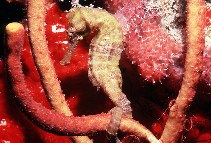| Family: |
Syngnathidae (Pipefishes and seahorses), subfamily: Syngnathinae |
| Max. size: |
17.5 cm OT (male/unsexed) |
| Environment: |
reef-associated; brackish; marine; depth range 0 - 60 m, non-migratory |
| Distribution: |
Western Atlantic: USA (North Carolina) to Brazil; the Caribbean Sea. |
| Diagnosis: |
Dorsal spines (total): 0-0; Dorsal soft rays (total): 16-19. Description: (based on 39 specimens): Adult height: 9.5-17.5cm. Rings: 11+35 (31-39). Snout length: 2.2 (2.0-2.5) in head length. Dorsal fin rays: 17 (16-19) covering 2+1 rings. Pectoral fin rays: 16 (15-17). Coronet: low-medium, rounded, may be quite large and convoluted (like
a crumpled piece of paper). Spines: none to low rounded tubercles. Other distinctive characters: broad, almost double cheek and eye spines; long, thick snout; narrow body; usually no skin appendages.
Color pattern: often profusely spotted with brown, with numerous tiny white dots (especially on tail); may have paler ‘saddles’ across dorsolateral surfaces. |
| Biology: |
Uncommon in most areas, but may be locally common in certain places. Usually attached to gorgonians or seagrasses but may occur in floating Sargassum or swimming freely in midwater (Ref. 9710). Ovoviviparous (Ref. 205). The male carries the eggs in a brood pouch which is found under the tail (Ref. 205). Has been reared in captivity (Ref. 35409). Length type refers to Height (= from top of coronet to the tip of straightened tail). Maximum depth reported taken from Ref. 128812. |
| IUCN Red List Status: |
Near Threatened (NT); Date assessed: 04 October 2016 (A2d+4d) Ref. (130435)
|
| Threat to humans: |
harmless |
| Country info: |
|
Source and more info: www.fishbase.org. For personal, classroom, and other internal use only. Not for publication.

